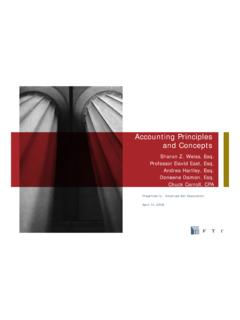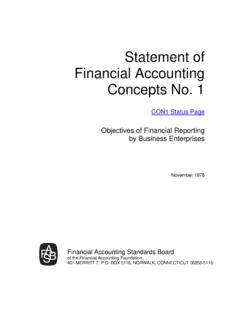Transcription of The FASB’s Conceptual Framework - SAGE Publications
1 223In Chapter 6, we examined a number of committee reports and documents emanating from the American Institute of Certified Public Accountants (AICPA), Accounting Principles Board (APB), and the American Accounting Association (AAA). The chronology of these documents is extremely impor-tant. The first one (ASOBAT, A Statement of Basic Accounting Theory) appeared shortly after ARSs 1 and 3 (the Moonitz and Sprouse and Moonitz postulates and principles studies) and the last one (SATTA, Statement of Accounting Theory and Theory Acceptance) appeared just prior to publica-tion of the first part of the Conceptual Framework .
2 Since all of the Chapter 6 7 The FASB s Conceptual FrameworkCHAPTERA fter reading this chapter, you should be able to: Recognize the linkage between the Conceptual Framework and the documents discussed in Chapter 6. Understand the components of the Conceptual Framework . Comprehend the trade-off problems that standard setters face. Appreciate the conflict between representational faithfulness and economic consequences. Assess empirical research on the Conceptual Framework . View the Conceptual Framework from the codificational standpoint and the jurisprudential Objectives224 ACCOUNTING THEORY documents became available just prior to the FASB s Conceptual Framework project, they played an important role in its development.
3 There are two important points to keep in mind as we examine the con-tents of the Conceptual Framework . First, the project can be viewed as an evolutionary document with important parts drawing heavily on the works just discussed. Second, while much criticism can (and will) be directed toward the Conceptual Framework , the document can be improved so that it may yet provide a sound underpinning for future accounting Conceptual Framework consists of eight different statements. Statement No. 7 came out in 2000, 15 years after Statement No.
4 6, then Statement No. 8 was not published until a decade later. Each of these eight parts is referred to as a statement of financial accounting concepts (SFAC), and our discussion of these parts proceeds chronologically. The eight SFACs and the year of publication by the FASB are:Statements of Financial Accounting Concepts:No. 1. OBJECTIVES OF FINANCIAL REPORTING BY BUSINESS ENTERPRISES (SFAC No. 1)1978No. 2. QUALITATIVE CHARACTERISTICS OF ACCOUNTING INFORMATION (SFAC No. 2)1980No. 3. ELEMENTS OF FINANCIAL STATEMENTS OF BUSINESS ENTERPRISES (SFAC No. 3)1980No.
5 4. OBJECTIVES OF FINANCIAL REPORTING BY NONBUSINESS ORGANIZATIONS (SFAC No. 4)1980No. 5. RECOGNITION AND MEASUREMENT IN FINANCIAL STATEMENTS OF BUSINESS ENTERPRISES (SFAC No. 5)1984No. 6. ELEMENTS OF FINANCIAL STATEMENTS; a replacement of FASB Concepts Statement N. 3, also incorporating an amendment of FASB concepts statement no . 2 (SFAC N. 6)1985No. 7. USING CASH FLOW INFORMATION AND PRESENT VALUE IN ACCOUNTING MEASUREMENTS (SFAC No. 7)2000No. 8. Conceptual Framework FOR FINANCIAL REPORTING, a replacement of SFAC No. 1 and No. 22010In this chapter, we provide a chronological overview of the SFACs and discuss some of the potential problem areas.
6 These include problems between two of the objectives and the question of whether representational The FASB s Conceptual Framework 225faithfulness or economic consequences (Chapter 4) should dominate in the standard-setting process. We close by examining some philosophical orien-tations to a Conceptual Framework and mention empirical research pertain-ing to the Conceptual Framework . Before proceeding to the details of the Conceptual Framework , we start by mentioning the discussion memoran-dum that preceded all of the above The FASB s Conceptual FrameworkThe Conceptual Framework is supposed to embody a coherent system of interrelated objectives and fundamentals that can lead to consistent standards and that prescribes the nature, function, and limits of financial accounting and financial statements.
7 2 The Conceptual Framework is an attempt to provide a metatheoretical structure for financial accounting. The project now includes eight statements of financial accounting concepts, initiated by an important discussion MemorandumA discussion memorandum is, of course, not the end product of the FASB s deliberations. However, the initial discussion memorandum for the Conceptual Framework was a massive study, perhaps the most extensive ever published by the FASB. In addition, it was widely disseminated and publi-cized.
8 The discussion memorandum was accompanied by another document pertaining to tentative conclusions of the Trueblood Report on This latter report accepted the Trueblood Report s user orientation and emphasis on cash flows but added little more of substance to the discussion memorandum brought up two new basic issues: (1) new views of financial accounting and orientations to the financial statements (discussed in Chapter 11), and (2) an outline of the various approaches to capital maintenance. In both cases, in order to elicit responses from the profession, the memorandum attempted to show the various alternatives and possibilities open for adoption.
9 In addition, it presented various defini-tions for such basic terms as assets, liabilities, revenues, expenses, gains, and losses along with a discussion of qualitative characteristics of financial statements. The most important new issue presented in the document is capital maintenance. Chapter 2 notes that this concept is concerned with how earn-ings are measured in terms of maintaining intact the firm s capital (assets minus liabilities) existing at the beginning of the period. This is an important 226 ACCOUNTING THEORY problem that should be given a very prominent place in the normative objectives of a metatheoretical structure.
10 It was not considered extensively, if at all, in any of the other documents discussed in Chapter of Financial Accounting ConceptsThe SFACs constitute the finished portion of the Conceptual Framework project. These statements are analogous to APB Statement 4 in one respect: Like that document, these statements do not establish generally accepted accounting principles (GAAP) and are not intended to invoke Rule 203 of the Rules of Conduct of the AICPA (which prohibits departures from GAAP). This weakness may be disappointing, but it nonetheless provides some important benefits.



















